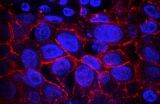Managing soil copper in crops irrigated with cattle footbath wastewater
2012-09-24
(Press-News.org) This press release is available in Spanish.
Getting a head start on stopping soil copper buildup will now be a bit easier, thanks to studies by U.S. Department of Agriculture (USDA) scientists. This research could help Pacific Northwest farmers develop long-term irrigation management strategies to protect crops from potentially dangerous soil copper levels.
Scientists with USDA's Agricultural Research Service (ARS) conducted a laboratory investigation to assess how copper levels in wastewater used for irrigation affected crop performance and soil microbial activities. ARS is USDA's chief intramural scientific research agency, and this work supports the USDA priority of promoting international food security.
The research was carried out by soil scientists Jim Ippolito and David Tarkalson and microbiologist Tom Ducey. Ippolito and Tarkalson work in the ARS Northwest Irrigation and Soils Research Laboratory in Kimberly, Idaho, and Ducey works at the ARS Coastal Plains Soil, Water and Plant Research Center in Florence, S.C.
Copper sulfate baths are used to prevent foot infections in dairy cattle, and the discarded foot bath is often recycled to irrigate corn and alfalfa crops. The scientists surveyed alfalfa growth and development in soils containing different levels of total copper. Copper sulfate at soil levels of up to 250 parts per million (ppm) had no effect on alfalfa growth, but alfalfa growth stopped when soil copper sulfate levels exceeded 500 ppm.
The team also discovered that beneficial soil bacterial activity declined when test soils accumulated available soil copper levels above 50 ppm. Further analysis indicated that soil levels above 63 ppm of plant-available copper resulted in alfalfa copper concentrations that could potentially harm grazing livestock, according to National Research Council guidelines.
Ippolito notes that in real-world conditions, soil copper accumulations and impacts will vary, depending on a range of factors. In addition, negative impacts might not be observed for anywhere from 15 to 75 years after irrigation begins.
###Read more about this research in the September 2012 issue of Agricultural Research magazine.
http://www.ars.usda.gov/is/AR/archive/sep12/cows0912.htm
USDA is an equal opportunity provider and employer. To file a complaint of discrimination, write: USDA, Office of the Assistant Secretary for Civil Rights, Office of Adjudication, 1400 Independence Ave., SW, Washington, DC 20250-9410 or call (866) 632-9992 (Toll-free Customer Service), (800) 877-8339 (Local or Federal relay), (866) 377-8642 (Relay voice users).
END
ELSE PRESS RELEASES FROM THIS DATE:
2012-09-24
A team of scientists with The Cancer Genome Atlas program reports their genetic characterization of 800 breast tumors, including finding some of the genetic causes of the most common forms of breast cancer, providing clues for new therapeutic targets, and identifying a molecular similarity between one sub-type of breast cancer and ovarian cancer.
Their findings, which offer a more comprehensive understanding of the mechanisms behind each sub-type of breast cancer, are reported in the September 23, 2012 online edition of the journal Nature.
The researchers, including ...
2012-09-24
SALT LAKE CITY, Sept. 23, 2012 – A University of Utah study suggests something amazing: Periodic changes in winds 15 to 30 miles high in the stratosphere influence the seas by striking a vulnerable "Achilles heel" in the North Atlantic and changing mile-deep ocean circulation patterns, which in turn affect Earth's climate.
"We found evidence that what happens in the stratosphere matters for the ocean circulation and therefore for climate," says Thomas Reichler, senior author of the study published online Sunday, Sept. 23 in the journal Nature Geoscience.
Scientists ...
2012-09-24
Instead, researchers were able to pin down a number of factors explaining the pronounced imbalances between emission importers and exporters, the US current account deficit being one of them. Their conclusion: interventions in world trade, like CO2 tariffs, would probably have only a small impact on global emissions.
Steadily growing world trade leads – as earlier research has shown – to a substantial transfer of CO2 from one country to another. The traded goods effectively contain the greenhouse gas, as it originates from the energy used during their production. "Typically, ...
2012-09-24
One subtype of breast cancer shares many genetic features with high-grade serous ovarian cancer, a cancer that is very difficult to treat, according to researchers supported by the National Institutes of Health. The findings suggest that the two cancers are of similar molecular origin, which may facilitate the comparison of therapeutic data for subtypes of breast and ovarian cancers.
The researchers, using data generated as part of The Cancer Genome Atlas (TCGA), described new insights into the four standard molecular subtypes based on a comprehensive characterization ...
2012-09-24
ROCHESTER, Minn. -- Mayo Clinic researchers and an international team of scientists have developed a highly-efficient means of editing zebrafish genomes for research purposes, eliminating a bottleneck that has stymied biomedical scientists from using the fish as a model for human disease. The details appear online today in the journal Nature.
For many researchers, zebrafish are becoming the model of choice for genetic studies. However, the inability to efficiently target genetic modifications has delayed their use by some. The Mayo team used an improved variant of artificial ...
2012-09-24
Bangkok, 24 September 2012 - A study of almost 200 major international water-related projects over the past 20 years has identified a suite of existing and emerging challenges and how science can offer remedies.
The Global Environment Facility (GEF), the largest public funder of projects to improve the global environment and promote sustainable development, partnered with the United Nations University and the United Nations Environment Programme (UNEP) to extract lessons from a portfolio of major transboundary water projects involving investments of more than US$7 billion.
Insufficient ...
2012-09-24
DURHAM, N.C. – In their quest for a cancer cure, researchers at the Duke Cancer Institute made a serendipitous discovery -- a molecule necessary for cheaper and greener ways to produce nylon.
The finding, described in the Sept. 23, 2012, issue of the journal Nature Chemical Biology, arose from an intriguing notion that some of the genetic and chemical changes in cancer tumors might be harnessed for beneficial uses.
"In our lab, we study genetic changes that cause healthy tissues to go bad and grow into tumors. The goal of this research is to understand how the tumors ...
2012-09-24
Germinal centers are sites in the organs of the lymphatic system, formed during the course of an immune response to infection, where B cells intensely proliferate and modify their DNA in order to produce antibodies specific for the pathogen. However, it is known that the vast majority of lymphomas derive from the B cells at the germinal centers. Now, Dr. Dinis Pedro Calado and Dr. Klaus Rajewsky of the Max Delbrück Center for Molecular Medicine (MDC) Berlin-Buch have identified subgroups of B cells in germinal centers in which the proto-oncogene Myc, a critical regulator ...
2012-09-24
The most comprehensive analysis yet of breast cancer shows that one of the most deadly subtypes is genetically more similar to ovarian tumors than to other breast cancers.
The findings, published online Sept. 23 in Nature, suggest that most basal-like breast tumors and ovarian tumors have similar genetic origins and potentially could be treated with the same drugs, says the study's co-leader Matthew J. Ellis, MD, PhD, the Anheuser-Busch Chair in Medical Oncology at Washington University School of Medicine in St. Louis. The other co-leader is Charles M. Perou, PhD, at ...
2012-09-24
Many survivors of adolescent and young adult cancers avoid routine medical care because it's too expensive, despite the fact that most have health insurance. That is the conclusion of a new study published early online in CANCER, a peer-reviewed journal of the American Cancer Society. The results indicate that expanding insurance coverage for young cancer survivors may be insufficient to safeguard their long-term health without efforts to reduce their medical cost burdens.
Medical care in the years after a cancer diagnosis is particularly important for detecting any long-term ...
LAST 30 PRESS RELEASES:
[Press-News.org] Managing soil copper in crops irrigated with cattle footbath wastewater



